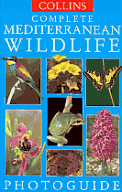Books and Good Reading.
Title:
Complete Mediterranean Wildlife Photoguide:
Author: Paul
Sterry. HarperCollins website link: www.fireandwater.com Price: Source: Book Sellers/Publisher. *(New Imprint July 2005 - ISBN 0-00-220161-5 Price 15.99).
And this is a reasonably sized tome. Including the introduction, glossaries, index etcetera it contains 384 pages (excluding the cover); weighs in at 645gms (1Ib 8ozs) and measures 20cm x 13.5cm x 2.5cm (8.5'x5.25"x11"). Big enough to weigh down a jacket pocket, but not a problem for a small backpack. Worth remembering because most books of this type are probably, unless you are competent with a camera, have a photographic memory (or are an underwater enthusiast), best taken out with you - used as field guides.This
introductory section of this excellent 384 page photo-guide is but 41
pages long, including at least one photograph per page.
Attractively presented it gets off to what seems a slow start, as
if searching for a theme, but quickly finds its feet and, like the rest
of the guide, becomes very interesting.
Perhaps one of the more relevant points is the proffered reason
for the creation of the book – the ready availability of specialist
books on various aspects – botany, bird watching about more northern
climes – but a lack of a
work catering for those people with an all round interest in Mediterranean
wildlife.
Hence this particular contribution. Overall,
Paul
Sterry presents the introduction extremely well - much better than the
average wildlife books I have read. The section on 'The Coast' for
example, divides that area up into Cliffs and
Coastal
Land; Rocky
Shores; Sandy Shores; Dunes; Estuaries; Mudflats; and
extends
to Salt Marshes and Saltpans and so on. Rather better than just saying
Coast or Coastline or Shore. A good start. Equally,
the section on Mediterranean climate and vegetation mentions the invariably warm seas and comments on the Mediterranean climate
exerting a profound influence upon the wildlife – well, one
can’t argue with that… So
how good are
the
contents of the book?
In a nutshell - for most wildlife enthusiasts it is good. It covers the
fields the title claims to cover. Except of course (tongue
in cheek!) areas such as microbiology
- though some would undoubtedly deny microbes a place in 'wildlife'. It
certainly covers much of everything else. You can, with a great deal of hard work and this book by Paul Sterry has achieved it - 99.9% anyway. There is no single picture size used but the pages seem to be based on a page content of 10, 12, 8 and 6 photographs. Mostly portrait (horizontal). Sometimes portrait (vertical). Sometimes a combination on the same page. But always seem to be selected on a basis of showing off the subject to the best effect. The majority of flowers, for example, are printed at 12 per page with an individual size of around 51X45MM easily good enough for the average flower identification picture. But therein lies a rub. There is no average flower. No two, even on the same plant, are ever exactly the same. Growth; blossom; seed; wither. Constant changes. But then as the author notes, available space often only permits the inclusion of a single specimen which in reality will occur at different times in different forms. But then, since we most of us use the mythical 'average' for anything and the ice-cream salesman this is not really a problem. Rather an indicator that care is needed when identifying specimens in reality.Ease of use - 95%. It is a scientific fact that we learn around 80% from sight. Looking at things.... A photoguide is an excellent method of both teaching, learning, revising - and this one makes the process very enjoyable - another plus. Not many of us like hard mental work and a book with coverage this wide could be very hard work. This one is anything but.Each photograph is identified by a very simple position guide on a facing page. Each position guide has an accompanying text entry with 7 or 8 lines of text giving essential information. It won't give you the genetic code of a specimen but has all the basic details to enable identification. Now why didn't I think of that? I have read this book several times - cover to cover - and applied some of the flower information/photographs in practice. I can't really fault any part of it to any serious degree. Even my criticisms of the generalisations found in some parts may not hold good if the reader is on the lower slopes of the learning curve. I remember vaguely attending a lecture on learning, many years ago, where the lecturer presented a limerick about the position of a new student in relation to the teacher and learning something new... It went something like this:- There
is something I don't know, that I am supposed (need) to know, Drawbacks. Only good as far south as Crete and Cyprus. No insider knowledge of particular locations. Did I buy one? I certainly did - within 24 hours of borrowing the copy for review.
Reviewer.
|
